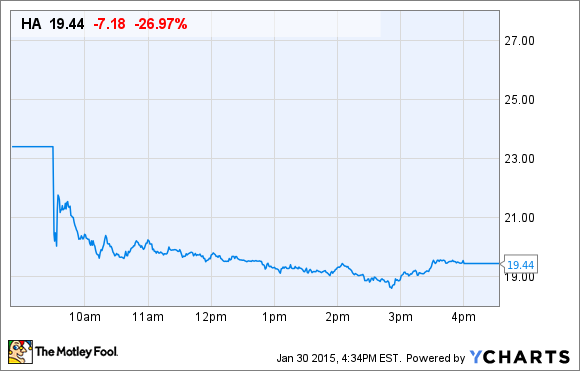Shares of Hawaiian Holdings, Inc. (HA 0.15%) plummeted 27% on Friday despite a solid earnings report, after the airline's first-quarter revenue outlook fell far short of expectations.
Hawaiian Holdings Friday Stock Chart, data by YCharts.
While Hawaiian's forecast was disappointing, long-term investors shouldn't worry. In fact, even though Hawaiian's unit revenue is likely to drop in 2015, the company is still on track for solid earnings growth thanks to the massive drop in oil prices since September.
Unit revenue troubles arise
Investors have poured into Hawaiian Airlines stock in the past few months, sending it up from less than $13 in mid-October to more than $27 just a week ago. This enthusiasm has been driven by two key factors: strong unit revenue performance and falling fuel prices.
Most U.S. airlines posted relatively flat unit revenue for the fourth quarter. By contrast, Hawaiian Airlines had projected back in October that unit revenue would rise 4.5% to 7.5% in Q4 -- and it delivered on its promises with 6.1% unit revenue growth.
However, Hawaiian Airlines management is now expecting an abrupt reversal of its unit revenue momentum. The company is forecasting a 3.5% to 6.5% drop in unit revenue for Q1 2015.

Hawaiian Airlines' unit revenue is under pressure.
On international routes, Hawaiian is suffering from two macro factors. The drop in oil prices is driving a corresponding decrease in fuel surcharges on routes to Japan and Korea. Additionally, the strong dollar is reducing the dollar value of tickets sold abroad. So far, Hawaiian Airlines hasn't been able to offset these headwinds with fare increases.
Meanwhile, overcapacity is hurting unit revenue on routes to the U.S. West Coast. Some of this has been caused by Hawaiian Airlines itself, as the carrier canceled some subpar international routes last spring and redeployed that capacity domestically.
2015 will still be a good year
In spite of Hawaiian Airlines' projected Q1 unit revenue decline, the company should still be able to deliver solid earnings growth this year. First, the benefit of lower fuel prices outweighs the revenue weakness. The company currently expects to pay $2.05 to $2.15 for jet fuel in Q1, down from $3.10 in Q1 2014.
Even at the high end of that range, Hawaiian Airlines will be paying 30% less for jet fuel. The company also expects a modest improvement in fuel efficiency. All told, Hawaiian's unit costs are on pace to fall about 8% to 9% year over year in Q1. Even with lower unit revenue, that will allow several points of margin expansion.
Looking ahead to the rest of 2015, unit revenue pressure should ease in the next few quarters, particularly for domestic routes. Q1 is a seasonally weak period for travel to Hawaii, making it harder to stimulate demand if there is extra capacity in the market. In seasonally stronger quarters, Hawaiian Airlines will have an easier time filling its West Coast flights.
The long-term solution
In recent years, Hawaiian Airlines has faced some ups and downs in the West Coast-Hawaii market. In late 2012, it confronted a similar overcapacity challenge. In response, Hawaiian trimmed its West Coast capacity, as did some of its competitors, and unit revenues began to stabilize by mid-2013.
Hawaiian Airlines is particularly susceptible to capacity imbalances today because it flies most of its long-haul routes once a day with a widebody aircraft (generally a 294-seat A330). This leaves it with limited tools to fine-tune capacity. For a given route on a particular day, Hawaiian Airlines can either operate a flight or not -- there is no in-between solution.

Hawaiian Airlines currently operates all long-haul flights with widebody planes. Photo: Wikimedia Commons.
In a few years, this will change. Hawaiian Airlines will take delivery of 16 A321neos from Airbus between 2017 and 2020. These planes will be outfitted with about 190 seats but will have unit costs similar to an A330. As a result, Hawaiian Airlines will be able to reduce capacity in West Coast markets where it has faced pricing pressure, without eliminating service altogether.
By 2020, Hawaiian Airlines will be able to match capacity to demand in a much more precise manner than it can today. This should lead to margin expansion. As a result, long-term investors shouldn't worry about Hawaiian Holdings' recent setback. The company's long-term profit trajectory is still very strong.




